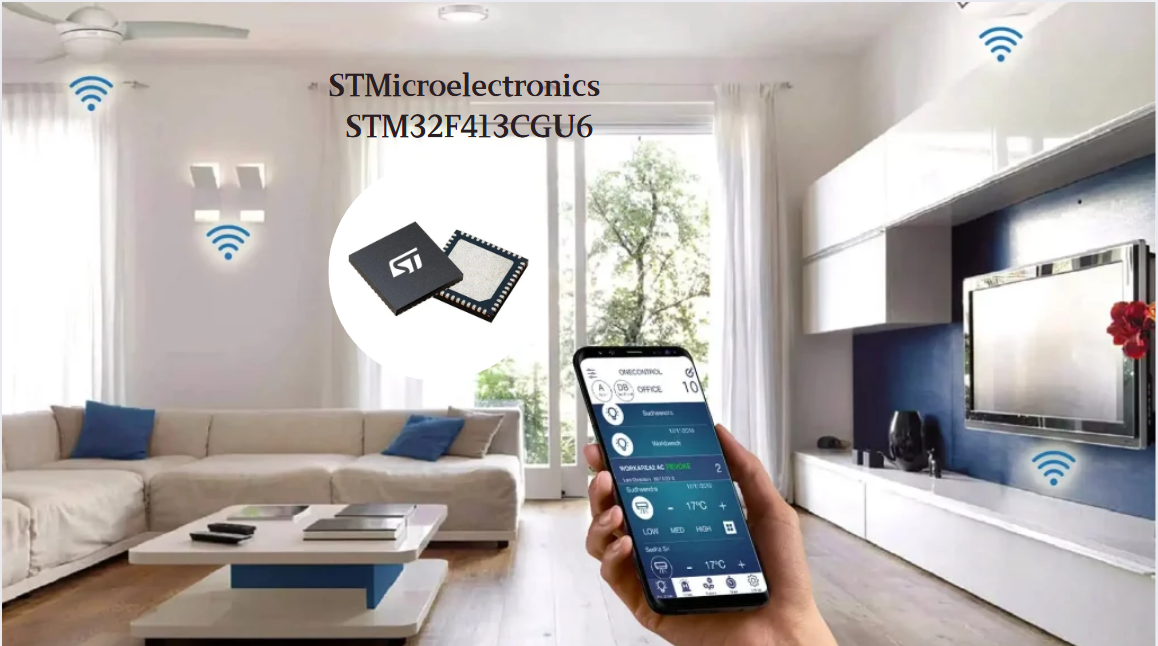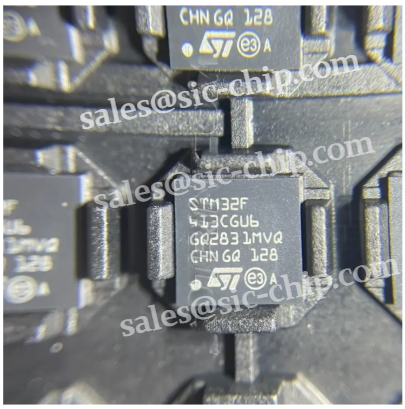STMicroelectronics STM32F413CGU6 +BOM
The STMicroelectronics STM32F413CGU6 is an Arm® Cortex®-M4 based MCU with FPU, operating at up to 100 MHz for 125 DMIPS performance. It features 1MB Flash, 320KB SRAM, and interfaces like USB OTG FS, 3 CAN, ADC, 2 DAC, and multiple serial ports. With low-power modes (Sleep, Stop, Standby), it suits industrial and medical applications. Housed in UFQFPN48 package, it operates at -40°C to +105°C, ideal for industrial control, audio processing, and low-power IoT devices.
STMicroelectronics STM32F413CGU6's Features
1. Processor Core
- Core: 32-bit Arm® Cortex®-M4 with Floating Point Unit (FPU), supporting DSP instructions and Memory Protection Unit (MPU).
- Performance: Up to 100 MHz clock speed, 125 DMIPS performance (Dhrystone 2.1 benchmark). Equipped with Adaptive Real-Time Accelerator™ (ART Accelerator™) for zero-wait-state flash execution.
2. Memory Configuration
- Flash Memory: 1024 KB (1 MB), supporting security features (read protection, PCROP) and One-Time Programmable (OTP) memory (512 bytes).
- SRAM: 320 KB (256 KB + 64 KB), enabling zero-wait-state access.
- External Memory Interface: 1 flexible static memory controller (FSMC) supporting SRAM/PSRAM/NOR Flash/LCD parallel interfaces (8/16-bit data bus).
3. Peripherals and Interfaces
Analog PeripheralsADC: 12-bit ADC with up to 2.4 MSPS, 16 channels, supporting analog watchdog and temperature sensor.
DAC: 2 x 12-bit DAC channels, supporting buffered mode and waveform generation (noise/triangle wave).
Digital Filters: 6 sigma-delta modulator digital filters (DFSDM) for microphone arrays and sound source localization.
- USB: 1 x USB 2.0 OTG full-speed controller (FS), supporting host/device modes.
- CAN: 3 x CAN 2.0B controllers (active mode), supporting up to 1 Mbit/s.
- Serial Interfaces:
- 3 x I2C (supporting Fast-mode Plus, 1 MHz).
- 3 x USART and 3 x UART (up to 12.5 Mbit/s).
- 5 x SPI/I2S (up to 50 Mbit/s, 2 full-duplex I2S).
- Other: 1 x SDIO/MMC interface (supporting SD/eMMC cards), 1 x Serial Audio Interface (SAI) for multi-protocol audio transmission.
- Advanced Timers: 2 x 16-bit advanced control timers (TIM1/TIM8), supporting PWM output and dead-time control.
- General Timers: 10 x 16/32-bit general timers, supporting input capture, output comparison, and quadrature encoder interfaces.
- Low-Power Timer: 1 x 16-bit low-power timer (LPTIM1) for wake-up from stop mode.
- Watchdogs: Independent Watchdog (IWDG) and Window Watchdog (WWDG).
4. Power and Low Power
- Power Range: 1.7 V to 3.6 V (VDD), supporting VBAT backup power (1.65 V to 3.6 V).
- Low-Power Modes:
- Sleep Mode: CPU stops, peripherals run; typical current 3 mA (@100 MHz, 3.3 V).
- Stop Mode: Minimum power mode; typical current 42 µA (Flash stop mode, 25°C), supporting fast wake-up.
- Standby Mode: Typical current 1.1 µA (without RTC), allowing RTC operation with VBAT power.
- Energy Efficiency: Dynamic Efficiency Line, enhanced batch acquisition mode (eBAM) to reduce data acquisition power consumption.
5. Package and Pins
- Package: UFQFPN48 (7x7 mm, 48 pins), supporting 36 GPIOs, with partial pins supporting 5 V tolerance.
- Pin Functions:
- Dedicated USB, CAN, SPI/I2S pins.
- Support for SWD/JTAG debug interfaces (2-wire debug).
6. Other Features
- Security and Encryption: True Random Number Generator (RNG), CRC calculation unit, 96-bit unique ID.
- Compatibility: Software-compatible with the STM32F4 series, enabling seamless replacement of other models (with PCB adjustments).
- Temperature Range: -40°C to +105°C (industrial grade), maximum junction temperature +125°C.
STMicroelectronics STM32F413CGU6's Applications
1. Industrial Automation and Control
- Industrial Robots and Motion Control: Utilizes 2 advanced control timers (TIM1/TIM8) to implement PWM output and dead-time control, supporting motor drives (such as servo motors, stepper motors). Achieves industrial bus communication (e.g., CANopen, DeviceNet) through 3 CAN 2.0B controllers.
- PLC and Smart Devices: With a 12-bit ADC (2.4 MSPS) and 6 DFSDM digital filters, it supports multi-channel analog signal acquisition (e.g., temperature, pressure sensors), suitable for industrial instruments and process control.
- Power Electronics and Inverters: Relying on the ART Accelerator™ for zero-wait-state flash execution, it enhances the efficiency of real-time control algorithms, supporting fast response in photovoltaic inverters, UPS, and other devices.
- High Reliability: Industrial-grade temperature range (-40°C to +105°C) and CRC check unit ensure data integrity in harsh environments.
- Real-time Communication: Supports USB 2.0 OTG FS and SDIO/MMC interfaces for convenient interaction with host computers or storage devices.
2. Medical Devices and Health Monitoring
Portable Medical Instruments: Such as blood glucose meters and ECG monitors, using 2 12-bit DACs to generate waveform signals, combined with a low-power timer (LPTIM1) for periodic data collection, reducing standby power consumption (typical standby current 1.1 µA).
Medical Imaging and Sensor Fusion: Connects to image sensors or audio modules via SPI/I2S interfaces, and implements encrypted communication with a true random number generator (RNG) to ensure data security.
Wearable Health Devices: With 320 KB SRAM and eBAM (enhanced batch acquisition mode), it efficiently processes physiological data such as heart rate and blood oxygen, while maintaining low power consumption (sleep mode current 3 mA).
- High-Precision Analog Peripherals: The ADC supports temperature sensors and medical-grade signal conditioning, with errors below ±4 LSB (typically ±2 LSB).
- Security Compliance: 96-bit unique ID and Memory Protection Unit (MPU) meet the data encryption and partition isolation requirements of medical devices.
3. Audio Processing and Intelligent Voice
- Smart Speakers and Speech Recognition: Through 5 SPI/I2S interfaces (2 full-duplex I2S) and an SAI serial audio interface, it supports multi-channel audio stream transmission (e.g., I2S, PDM microphone arrays). Uses DFSDM digital filters for sound source localization and beamforming.
- Home Audio Systems: With a PLLI2S dedicated audio PLL to generate high-precision clocks (supporting 8 kHz to 192 kHz sampling rates), it ensures distortion-free audio signals, suitable for DAC audio output or CODEC interfaces.
- Voice-Activated Devices: Combining low-power modes (stop mode current 42 µA) and a real-time clock (RTC) enables voice-triggered wake-up in standby mode, extending battery life.
- Hardware-Accelerated Processing: DSP instructions and FPU unit optimize audio algorithms (e.g., FFT, noise reduction), reducing CPU load.
- Low-Latency Communication: SPI5/I2S5 supports up to 50 Mbit/s, meeting real-time audio stream transmission requirements.
4. IoT and Smart Home
- Sensor Hubs and Gateways: Connects to multiple sensors (e.g., temperature/humidity, air pressure) via 3 I2C interfaces (1 MHz Fast-mode Plus), and uses a DMA controller for batch data transmission, reducing CPU intervention.
- Smart Home Appliance Control: Uses USART/UART interfaces (up to 12.5 Mbit/s) to connect Wi-Fi/Bluetooth modules, supporting OTA upgrades. Directly drives relays or LED indicators via GPIO 5V tolerance.
- Wearable Devices: With a small UFQFPN48 package (7x7 mm) and low-power design, it integrates motion sensors (e.g., accelerometers) for step counting, sleep monitoring, etc.
- Energy Efficiency Optimization: Dynamic voltage scaling (1.7 V to 3.6 V) and fast Stop mode wake-up (typically 10 µs) balance performance and power consumption.
- Strong Expandability: Supports FSMC external memory interface for expanding NOR Flash or SRAM to meet IoT device data storage needs.
5. Automotive Electronics and In-Vehicle Applications
- In-Vehicle Sensors and Actuators: Uses CAN bus for in-vehicle network communication (e.g., body control modules), and monitors battery or motor temperature via an ADC temperature sensor.
- In-Vehicle Audio Systems: Connects to in-vehicle audio CODECs via I2S interfaces for high-fidelity audio playback, and external flash for audio firmware via QSPI interfaces.
- Anti-Interference Capability: Complies with industrial-grade EMC standards, supports wide voltage ranges and power noise suppression, adapting to in-vehicle electromagnetic environments.
- Real-time Assurance: 100 MHz main frequency and NVIC nested interrupt controller ensure fast response to in-vehicle events.
6. Other Cutting-Edge Applications
- Industrial IoT (IIoT) Edge Nodes: Combined with ETH peripherals (requiring external PHY) and local storage, it enables edge data preprocessing and edge computing.
- Drone and Robot Control: Uses quadrature encoder interfaces and multi-timer synchronization for closed-loop motor speed control and attitude sensor fusion.
Summary: Core Competitiveness and Selection Recommendations
- Storage Requirements: 1 MB Flash and 320 KB SRAM are suitable for medium-scale firmware; expand via FSMC/QSPI for larger storage needs.
- Power-Sensitive Scenarios: Prioritize Stop mode (42 µA) or Standby mode (1.1 µA), paired with VBAT to maintain RTC operation.
Development Ecosystem: Compatible with the STM32Cube ecosystem, supporting HAL libraries and third-party RTOS (e.g., FreeRTOS) to shorten development cycles.

STMicroelectronics STM32F413CGU6's Attributes
| Type | Description |
|---|---|
| Category | Integrated Circuits (ICs) Embedded Microcontrollers |
| Mfr | STMicroelectronics |
| Series | STM32F4 |
| Packaging | Tray |
| Part Status | Active |
| DigiKey Programmable | Not Verified |
| Core Processor | ARM® Cortex®-M4 |
| Core Size | 32-Bit Single-Core |
| Speed | 100MHz |
| Connectivity | CANbus, EBI/EMI, I2C, IrDA, LINbus, MMC/SDIO, QSPI, SAI, SPI, UART/USART, USB OTG |
| Peripherals | Brown-out Detect/Reset, DMA, I2S, LCD, POR, PWM, WDT |
| Number of I/O | 36 |
| Program Memory Size | 1MB (1M x 8) |
| Program Memory Type | FLASH |
| RAM Size | 320K x 8 |
| Voltage - Supply (Vcc/Vdd) | 1.7V ~ 3.6V |
| Data Converters | A/D 10x12b; D/A 2x12b |
| Oscillator Type | Internal |
| Operating Temperature | -40°C ~ 85°C (TA) |
| Mounting Type | Surface Mount |
| Supplier Device Package | 48-UFQFPN (7x7) |
| Package / Case | 48-UFQFN Exposed Pad |
| Base Product Number | STM32F413 |
STMicroelectronics STM32F413CGU6's Datasheet

STMicroelectronics STM32F413CGU6's Symbol and Footprint

STMicroelectronics STM32F413CGU6's Category- Microcontroller
STMicroelectronics has been a leading player in the microcontroller space, and its STM32F413CGU6 stands out as a high-performance example. Built on the Arm® Cortex®-M4 core with an FPU, this microcontroller offers up to 100 MHz processing speed and 125 DMIPS performance, ensuring rapid execution of complex algorithms. It features 1 MB Flash memory, 320 KB SRAM, and a rich set of peripherals like USB OTG FS, CAN controllers, and advanced ADC/DAC modules, making it ideal for industrial control, medical devices, and audio processing applications. Its dynamic power management, including low-power modes like Stop and Standby, enhances battery efficiency in portable systems. With robust security features and a compact UFQFPN48 package, the STM32F413CGU6 exemplifies how microcontrollers continue to push the boundaries of performance and versatility, enabling smarter, more efficient embedded solutions across the globe.
STM32F413CGU6's Manufacturer-STMicroelectronics
ST’s commitment to low-power design is evident in modes like Stop (42 µA typ.) and Standby (1.1 µA typ.), enhanced by technologies like the Dynamic Efficiency Line and eBAM (enhanced Batch Acquisition Mode), making its MCUs ideal for battery-powered devices. The portfolio extends to ultra-low-power STM32L series for wearables and energy-sensitive applications, while the STM32H7 series pushes performance boundaries with dual-core Cortex-M7/M4 and advanced security features.
With a robust ecosystem including STM32CubeMX, HAL libraries, and RTOS compatibility, ST simplifies development, accelerating time-to-market. Its MCUs dominate in industrial automation, medical devices, automotive electronics, and consumer gadgets, praised for reliability and scalability. By combining cutting-edge architecture, rich peripherals, and sustainable design, ST continues to shape the MCU landscape, enabling smarter, more efficient embedded solutions worldwide.
STM32F413CGU6 vs STM32L011F4U6
| Part number | Manufacturer | Package | Description |
|---|---|---|---|
| STM32F413CGU6 | STMicroelectronics, Inc | UFQFN-48 | 1MB ARM-M4 Microcontroller Unit with 320KB Flash |
| STM32L011F4U6 | STMicroelectronics, Inc | QFN | RISC MICROCONTROLLER |










 Wishlist (0 Items)
Wishlist (0 Items) 